Unit 2 Is this your pencil Period 1 & 2教案设计示例[上学期]
文档属性
| 名称 | Unit 2 Is this your pencil Period 1 & 2教案设计示例[上学期] | 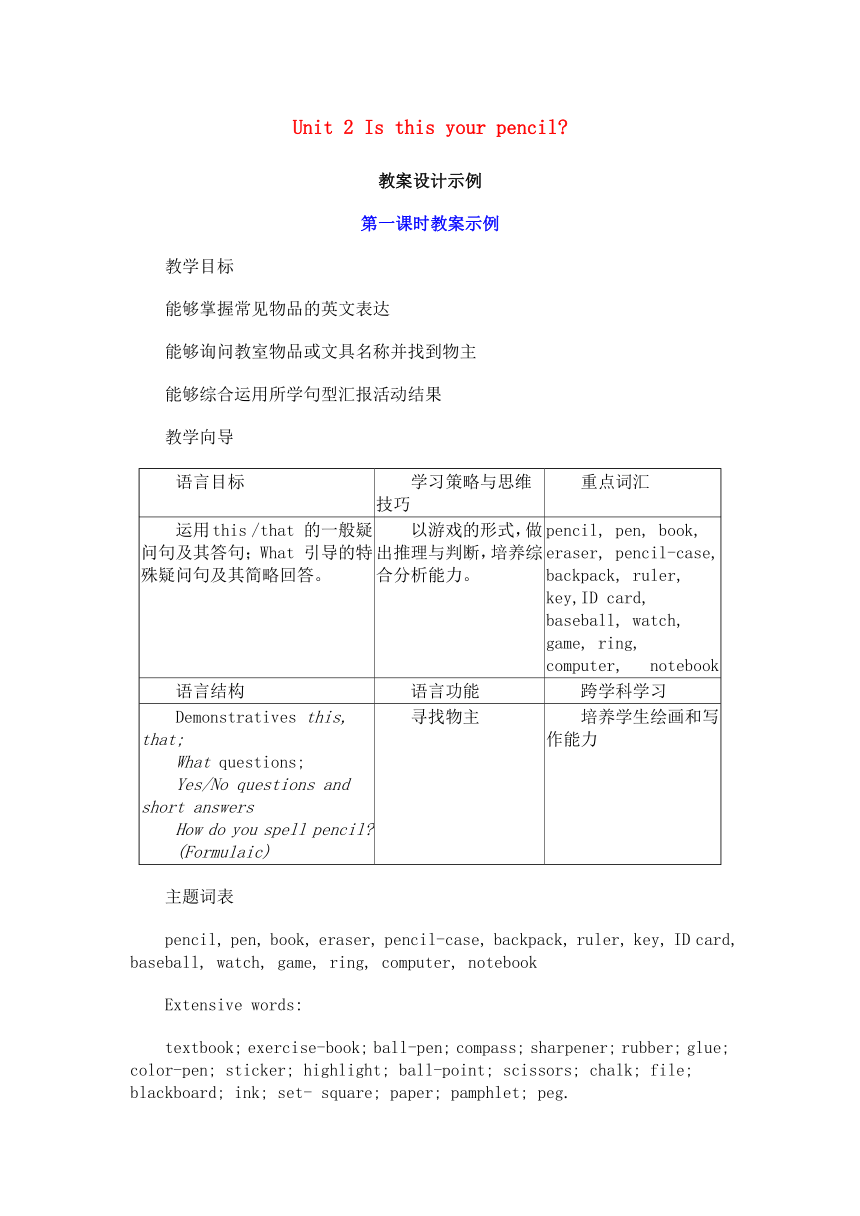 | |
| 格式 | rar | ||
| 文件大小 | 44.7KB | ||
| 资源类型 | 教案 | ||
| 版本资源 | 人教新目标(Go for it)版 | ||
| 科目 | 英语 | ||
| 更新时间 | 2007-10-22 12:09:00 | ||
图片预览

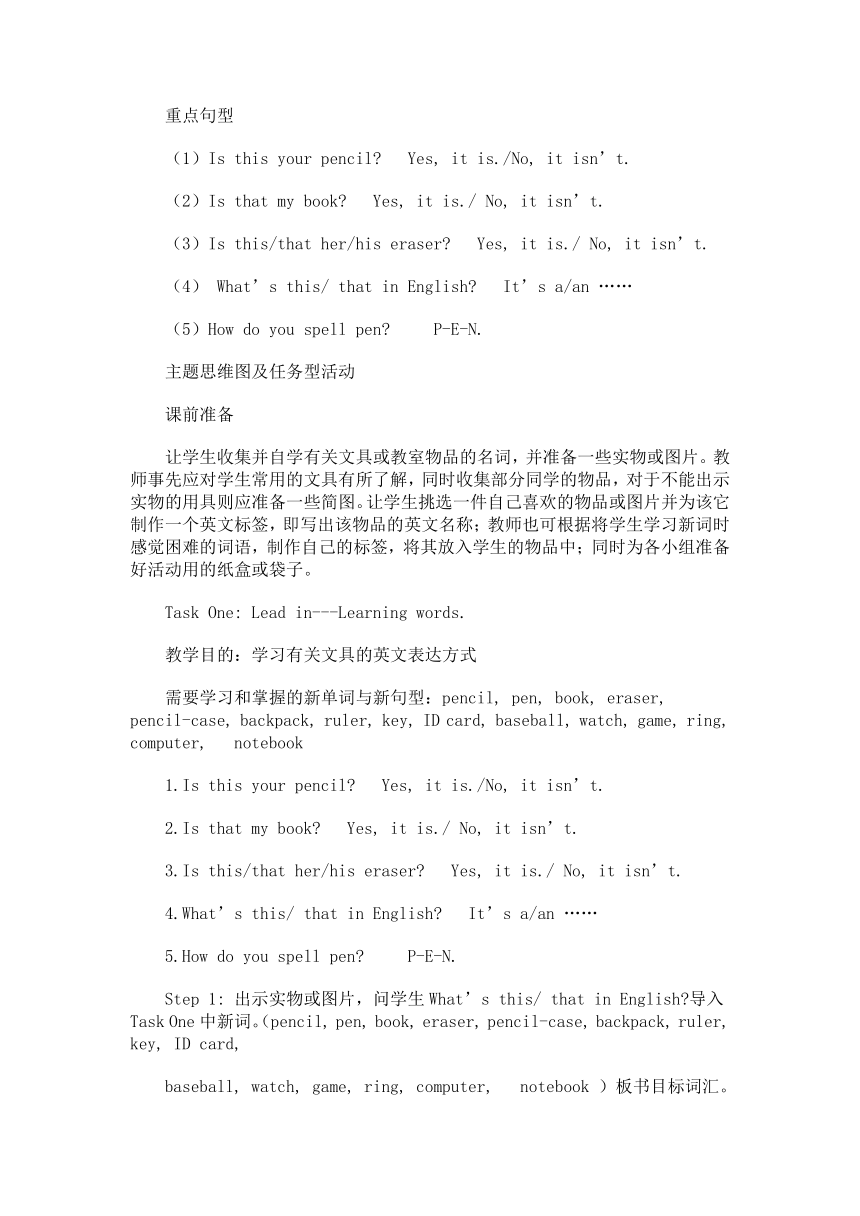
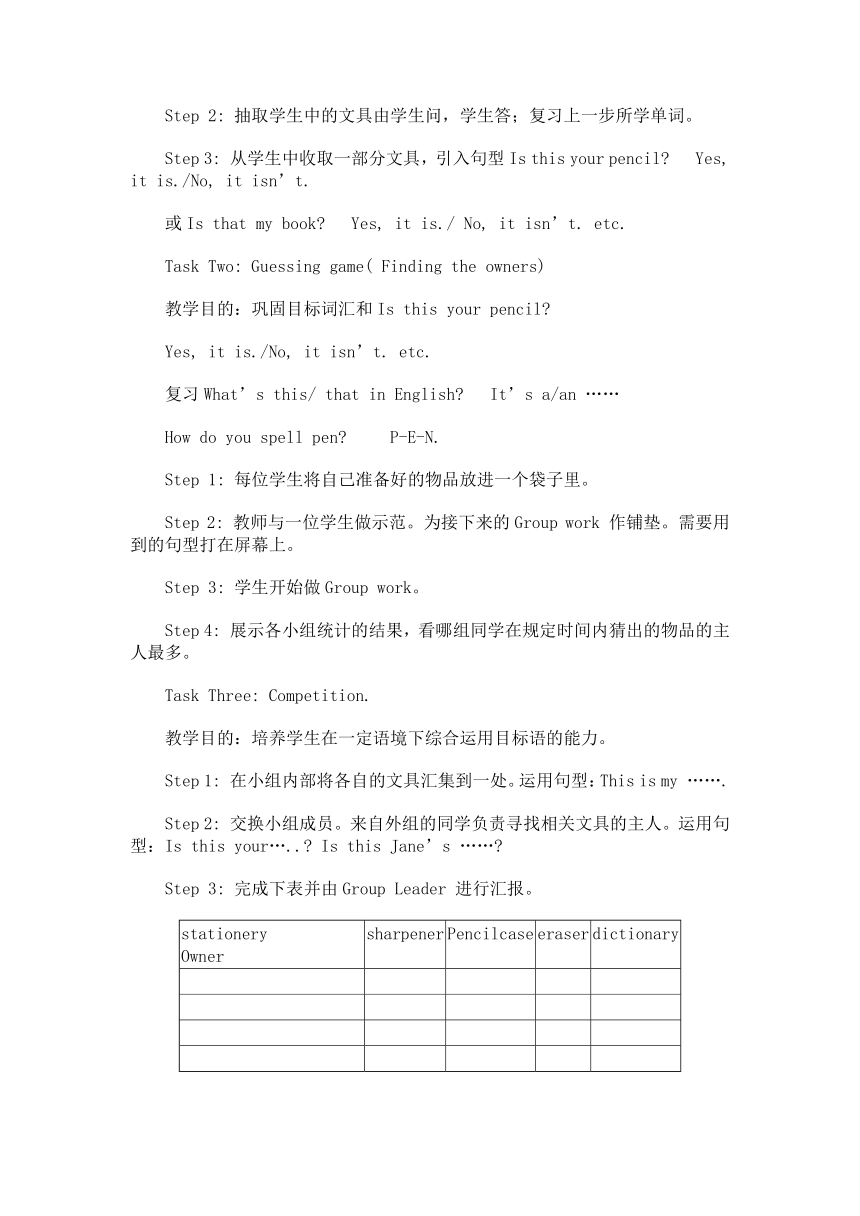
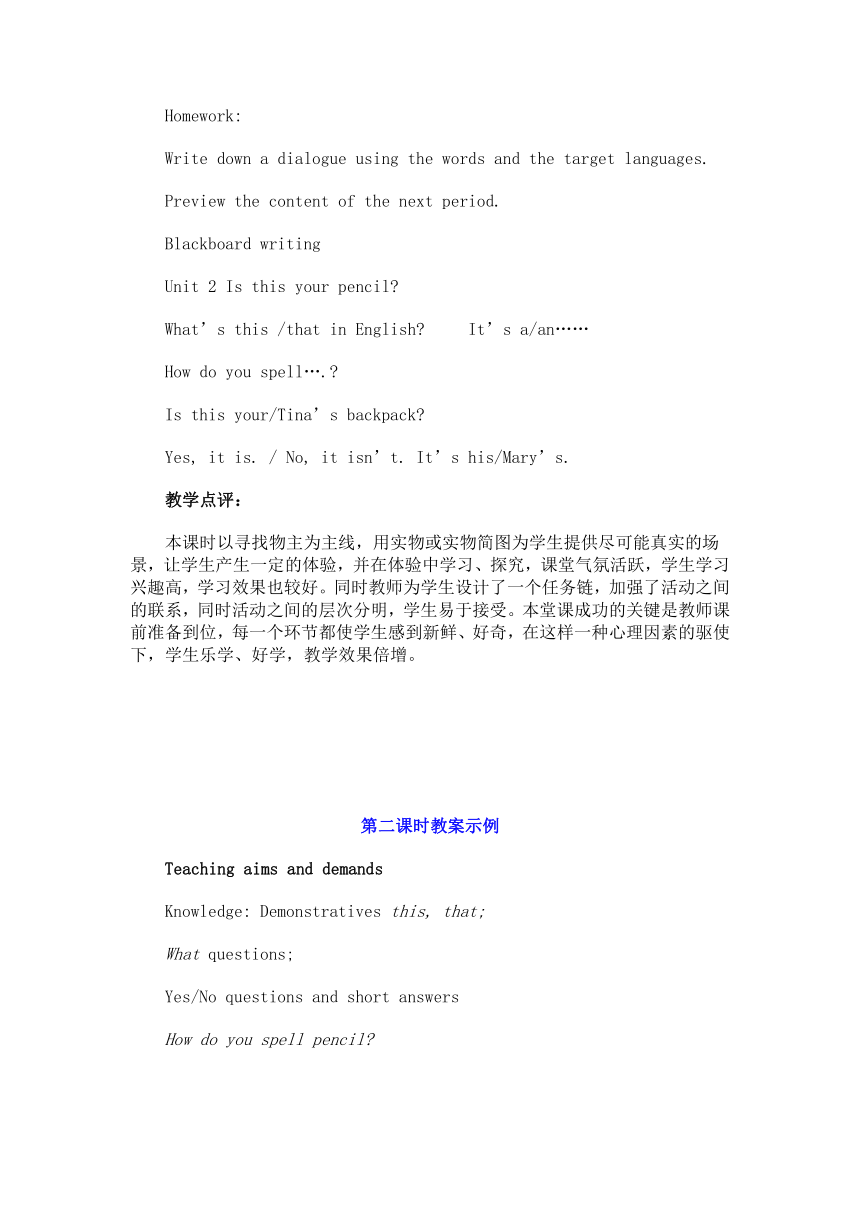
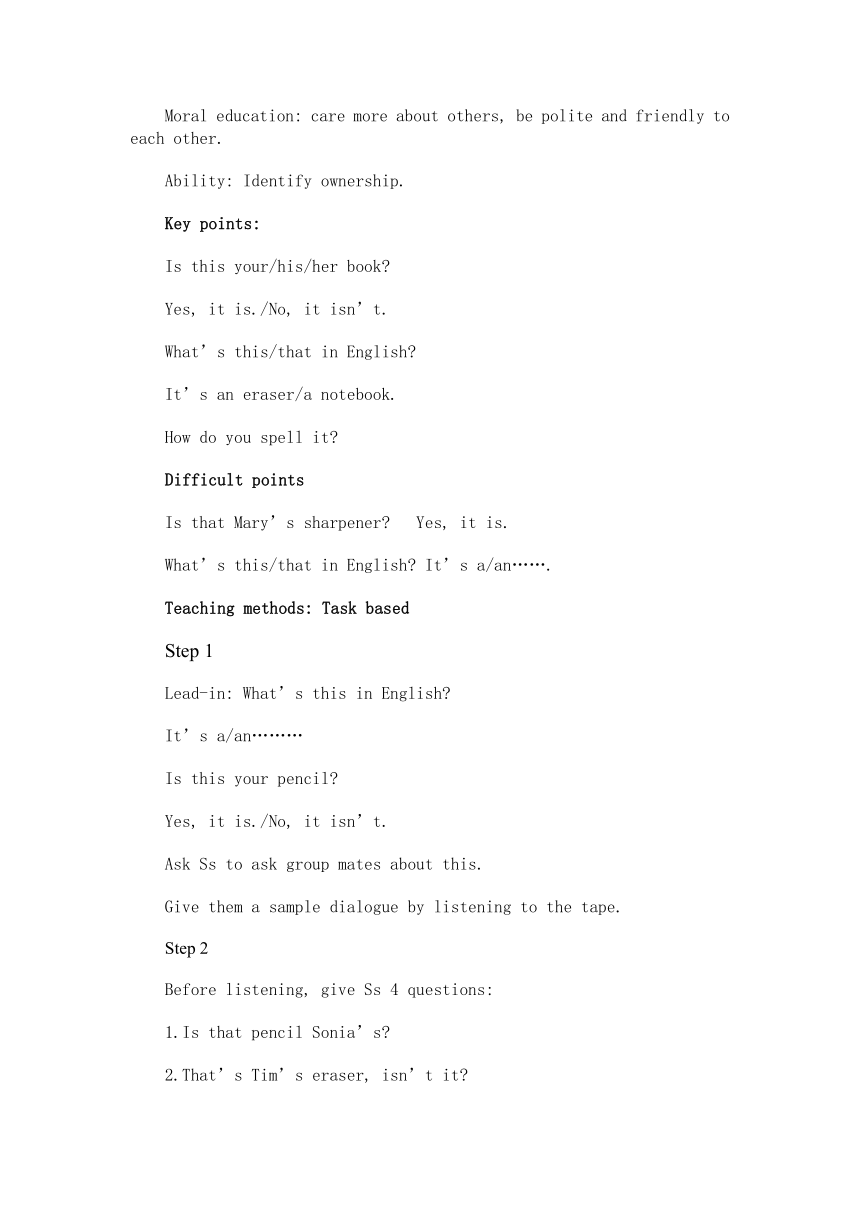
文档简介
Unit 2 Is this your pencil
教案设计示例
第一课时教案示例
教学目标
能够掌握常见物品的英文表达
能够询问教室物品或文具名称并找到物主
能够综合运用所学句型汇报活动结果
教学向导
语言目标 学习策略与思维技巧 重点词汇
运用this /that 的一般疑问句及其答句;What 引导的特殊疑问句及其简略回答。 以游戏的形式,做出推理与判断,培养综合分析能力。 pencil, pen, book, eraser, pencil-case, backpack, ruler, key,ID card, baseball, watch, game, ring, computer, notebook
语言结构 语言功能 跨学科学习
Demonstratives this, that;
What questions;
Yes/No questions and short answers
How do you spell pencil
(Formulaic) 寻找物主 培养学生绘画和写作能力
主题词表
pencil, pen, book, eraser, pencil-case, backpack, ruler, key, ID card, baseball, watch, game, ring, computer, notebook
Extensive words:
textbook; exercise-book; ball-pen; compass; sharpener; rubber; glue; color-pen; sticker; highlight; ball-point; scissors; chalk; file; blackboard; ink; set- square; paper; pamphlet; peg.
重点句型
(1)Is this your pencil Yes, it is./No, it isn’t.
(2)Is that my book Yes, it is./ No, it isn’t.
(3)Is this/that her/his eraser Yes, it is./ No, it isn’t.
(4) What’s this/ that in English It’s a/an ……
(5)How do you spell pen P-E-N.
主题思维图及任务型活动
课前准备
让学生收集并自学有关文具或教室物品的名词,并准备一些实物或图片。教师事先应对学生常用的文具有所了解,同时收集部分同学的物品,对于不能出示实物的用具则应准备一些简图。让学生挑选一件自己喜欢的物品或图片并为该它制作一个英文标签,即写出该物品的英文名称;教师也可根据将学生学习新词时感觉困难的词语,制作自己的标签,将其放入学生的物品中;同时为各小组准备好活动用的纸盒或袋子。
Task One: Lead in---Learning words.
教学目的:学习有关文具的英文表达方式
需要学习和掌握的新单词与新句型:pencil, pen, book, eraser, pencil-case, backpack, ruler, key, ID card, baseball, watch, game, ring, computer, notebook
1.Is this your pencil Yes, it is./No, it isn’t.
2.Is that my book Yes, it is./ No, it isn’t.
3.Is this/that her/his eraser Yes, it is./ No, it isn’t.
4.What’s this/ that in English It’s a/an ……
5.How do you spell pen P-E-N.
Step 1: 出示实物或图片,问学生What’s this/ that in English 导入Task One中新词。(pencil, pen, book, eraser, pencil-case, backpack, ruler, key, ID card,
baseball, watch, game, ring, computer, notebook )板书目标词汇。
Step 2: 抽取学生中的文具由学生问,学生答;复习上一步所学单词。
Step 3: 从学生中收取一部分文具,引入句型Is this your pencil Yes, it is./No, it isn’t.
或Is that my book Yes, it is./ No, it isn’t. etc.
Task Two: Guessing game( Finding the owners)
教学目的:巩固目标词汇和Is this your pencil
Yes, it is./No, it isn’t. etc.
复习What’s this/ that in English It’s a/an ……
How do you spell pen P-E-N.
Step 1: 每位学生将自己准备好的物品放进一个袋子里。
Step 2: 教师与一位学生做示范。为接下来的Group work 作铺垫。需要用到的句型打在屏幕上。
Step 3: 学生开始做Group work。
Step 4: 展示各小组统计的结果,看哪组同学在规定时间内猜出的物品的主人最多。
Task Three: Competition.
教学目的:培养学生在一定语境下综合运用目标语的能力。
Step 1: 在小组内部将各自的文具汇集到一处。运用句型:This is my …….
Step 2: 交换小组成员。来自外组的同学负责寻找相关文具的主人。运用句型:Is this your….. Is this Jane’s ……
Step 3: 完成下表并由Group Leader 进行汇报。
stationery
Owner sharpener Pencilcase eraser dictionary
Homework:
Write down a dialogue using the words and the target languages.
Preview the content of the next period.
Blackboard writing
Unit 2 Is this your pencil
What’s this /that in English It’s a/an……
How do you spell….
Is this your/Tina’s backpack
Yes, it is. / No, it isn’t. It’s his/Mary’s.
教学点评:
本课时以寻找物主为主线,用实物或实物简图为学生提供尽可能真实的场景,让学生产生一定的体验,并在体验中学习、探究,课堂气氛活跃,学生学习兴趣高,学习效果也较好。同时教师为学生设计了一个任务链,加强了活动之间的联系,同时活动之间的层次分明,学生易于接受。本堂课成功的关键是教师课前准备到位,每一个环节都使学生感到新鲜、好奇,在这样一种心理因素的驱使下,学生乐学、好学,教学效果倍增。
第二课时教案示例
Teaching aims and demands
Knowledge: Demonstratives this, that;
What questions;
Yes/No questions and short answers
How do you spell pencil
Moral education: care more about others, be polite and friendly to each other.
Ability: Identify ownership.
Key points:
Is this your/his/her book
Yes, it is./No, it isn’t.
What’s this/that in English
It’s an eraser/a notebook.
How do you spell it
Difficult points
Is that Mary’s sharpener Yes, it is.
What’s this/that in English It’s a/an…….
Teaching methods: Task based
Step 1
Lead-in: What’s this in English
It’s a/an………
Is this your pencil
Yes, it is./No, it isn’t.
Ask Ss to ask group mates about this.
Give them a sample dialogue by listening to the tape.
Step 2
Before listening, give Ss 4 questions:
1.Is that pencil Sonia’s
2.That’s Tim’s eraser, isn’t it
3.Is this Jane’s ruler
4.This is Tim’s pencil-case, isn’t it
Listen to a dialogue. Ask the students to take notes. Then answer the questions.
Step 3 Listen to the dialogue again.
Ask the students some sentences they’ve got from the dialogue.
Write down the key sentences down on the blackboard
Step 4 Group work:
Ask the students to ask the group mates. Fill in a form as below.
stationery owner
pencil-case
notebook
pencil sharpener
.
Step 5
Ask the group leader to do a report, and the other students take notes.
Ask Ss to think about the reports the other students do.
Step 6 Homework:
To make a dialogue by using the target language.
To write a “Lost and found case”.
Blackboard writing:
Unit 2 Is this your pencil
Is this/that your pencil Yes, it is./ No, it isn’t.
What’s this/that in English It’s a/an……….
How do you spell…….
教学点评:
本节课主要从调动学生学习兴趣出发,为学生创设尽可能真实的情境,给学生充分发挥自我的空间。让学生在做中学。虽然教学内容本身并不难,但学生差异极大,若按照传统教学方法讲授知识,单纯教单词和句型,课堂会显得很枯燥。学生若没有兴趣,学生效果将大打折扣。
本课除了为学生创设了贴近他们实际生活的活动,而且将学生分成不同的小组,这样既加强了学生之间的合作,为学生提供了互相学习和互相帮助的机会,同时又使得学生的个性特长得以发挥, 也为更多的学生提供了参与活动、提高语言运用能力的机会。教学过程中,尽可能对学生的表现进行激励评价,进一步培养学生学习英语的自信心。
探究活动
收集有关英文缩略词
让学生收集有关英文缩略词并说出其中文意思:
P(停放);W(西);S(南);E(东);N(北);USA(美国); XO(一种酒); UFO(不明飞行物); BTV(北京电视台); CCTV(中央电视台);P.R.C.(中华人民共和国); UK(英国); WTO(世界贸易组织); RMB(人民币); FM(调频); BA(文学士); AA(文科准学士); PC(个人用计算机);NBA(世界篮球); PE(体育); BBS(电子布告栏系统);SOS(求救信号); am(上午); pm(下午); CD(光盘); AD(公元); BC(公元前);
摸一摸, 猜一猜
让学生采用多种猜测的方法学习句型。如:全部遮盖物品、局部遮盖物品。教师将需要确认的物品,用布全部或局部的遮盖起来,让学生触摸,教师或其他学生问:What’s this Is this a/an… 接着请学生移开遮盖物,显露出物品,回答:It’s a/an…. Yes, it is./No, it isn’t.
Find out the owner
让学生将下列人物和物品配对后,填写下列表格,然后让同伴运用所学目标语进行猜测,
完成另外一份表格。
Bob John Ken Jennifer
Bob John Ken Jennifer
习题精选
改错
阅读以下句子,判断正误 。正确的写T, 错误的写F。
( )1. A key opens a door.
( )2. You write in a ruler.
( )3. "D" is the fifth letter in the alphabet.
( )4. Pencils may have erasers.
( )5. You play computer games in a backpack.
情景选择
根据语境,选择适当的答语。
(1) Mary finds a ring. She asks,
A. "What's your name " B. "Is this your ring "
(2) John and Sally meet. John says,
A. "Goodbye, Sally. B. "Hello, I'm John."
(3) Jane finds his watch. She says,
A. "No, it isn't." B. "This is his."
(4) You don't know what it is. You ask,
A. "How do you spell it " B. "What's this "
(5) "What's this " You say,
A. "It's my backpack." B. "I'm fine."
用a或an填空
(1) This is _________ book.
(2) This is _________ eraser.
(3) That is _________ notebook.
(4) That is _________ ID card.
(5) This is _________ English book.
扩展资料
巧学a和an
a和an很相像(1),
两者用法不一样:
辅音单数a提前,
元音单数an优先(2)。
代在名前来相伴,
a和an看不见(3)。
注解:
(1)a和an均为不定冠词,用于单数可数名词前,强调其类别,表泛指的“一(个、块、只)……”
(2)a用于辅音音素(而不是辅音字母)开头的单数可数名词前,an用于元音音素(而不是元音字母)开头的单数可数名词前。
(3)如单数可数名词前有this、that、my等代词修饰时,则不再使用a或an。
快速选择
1. This is___bag.
A.my B.my a C.a my
2. This isn’t___Japanese map.
That is___English map.
A.a;a B.an;an C.a;an
This和that用法归纳
This和that是英语中两个最基本、最常用的指示代词,它们的区别是:
1. 当涉及辨认近物和远物时用this和that加以区分,如:This is a book.这是一本书。(指近处物品)
That is a car.那是一辆小汽车。(指远处物品)
--- What is that 那是什么?(问远处物品)
--- It is a jeep. 它是一辆吉普车。
2. 介绍放在一起的两样东西时,先介绍的用this,后介绍的用that。如:This is a pen. That is a pencil. 这是一支钢笔,那是一支铅笔。
3. 把某人介绍给第三者时,常使用“This is …”这一句型,其中This不能换成He或She。如:Jim, this is my teacher, Mr. Black.吉姆,这是我的老师,布莱克先生。
4. 打电话,向对方介绍自己时要用“This is …”。询问或确认对方是哪一位时,可以说“Who's that ”(你是谁?)或 “Is that …?”。如:
--- This is Kate, who's that 我是凯特,你是谁?
--- This is Jim. 我是吉姆。
总之,打电话时习惯用this指代自己,用 that 指代对方。
摘自:www.
扩充词汇
textbook; exercise-book; ball-pen; compass; sharpener; rubber; glue; color-pen; sticker; highlight; ball-point; scissors; chalk; file; blackboard; ink; set-square; paper; pamphlet; peg.
初中英语新教材“ Go for it! ” Unit2 教材分析
背景分析 1 .教材概述 此套教材是人民教育出版社和美国 Thomson Learning 出版集团首次合作的系列产品,它是在 Thomson Learning2000 年最新出版的教材 Go for it 的基础上,合作编写而成。它集合了美式英语的特点也融入了中国的教学理念,整书没有一个中文字,意在强迫学生用英语的思维去学习英语,创造一种学习英语的氛围,本书着重于文化背景知识和学习策略等部分,较其他教材增加了任务型学习成份和语篇输入。 新目标英语教材( Go For It! )有以下几个特色 : (一)图文并茂。翻开课本,你都能够在每一页上看到一幅副充满情趣,幽默生动的画面,令你眼睛一亮。 (二)实用性强。每个单元的选材都来源于学生的学习和生活。紧紧地与学生的年龄特征、认知结构、生活经验联系在一起。 (三)注重交际。针对中国学生学英语普遍存在的“聋哑病”,教材设计了大量的听说读写材料。 (四)词汇量大。第一册有词汇 700 个左右,第二册约 450 个,第三册约 450 个,第四册约 400 个,第五册约 500 个,合计 2500 个。这一点正好达到《英语课程标准》 5 级的要求。 2 .单元分析 本单元的标题为 Is this your pencil 话题为 Things in the classroom. 本单元围绕“识别物品的所属”,使学生学会询问物品的主人的基本句型“ Is this/that your/her/his pencil Yes, it is. No, it isn't. ”,体会一般疑问句的用法;学习如何写“失物招领、寻物启事”,巩固所学单词的拼写“ How do you spell pen P-E-N. ”。通过以上几个方面的学习,既能提高学生解决问题的能力,又能巩固所学知识。本单元与第三单元衔接紧密:由 this , that 的学习过渡到 these, those 的学习,由指示一个人、物过渡到指示多个人、物,使学生学会区分远近单复数。下面将通过一个表格对本单元的教学作进一步的梳理。 语言功能 语言目标 辨认物品的所有者 询问物品的归属,以及英语中对应的表达法 对物品的所属进行提问和回答 语言结构 重点词汇 指示代词: this, that What 引导的特殊疑问句 Yes/No 问句及其简单回答句型 How do you spell pencil Pencil, pen, book, eraser, ruler, pencil case, dictionary, backpack, baseball, watch, key, computer game, notebook, ring 学习策略和思维技巧 跨学科学习 通过上下文内在的逻辑关系,完成对话等练习。 通过猜测这一练习,复习字母和单词拼写。 艺术:画出所学物品并依此编写对话。 视觉能力:利用卡通画学习单词和句型。 根据《英语课程标准》(实验稿)关于总目标的具体描述,结合第二单元的教材内容,我们分语言知识、语言技能、学习策略、情感态度、文化意识五个方面将本单元的教学目标细化: 1 )语言知识: 单词:学习掌握词汇 pencil, pen, book, eraser, ruler, pencil case, dictionary, backpack, baseball, watch, key, computer game, notebook, ring 等。 功能:辨认物品的所有者 询问物品的归属,以及英语中对应的表达法 Is this your pencil Yes, it is./No, it isn't…etc. 语言结构:指示代词: this, that What 引导的特殊疑问句 Yes/No 问句及其简单回答 句型 How do you spell pencil 2 )语言技能: 听:能识别不同句式的语调,并能根据语调变化,判断句子意义的变化;能听懂本课学习活动中的问题,作出较得体的回答。 说:能在本课的任务型活动如:失物招领、制作海报、编写谜语等中进行简单有效的交流。 读:能正确朗读本单元课文;能查阅工具书为完成任务做准备;能阅读有关外国学校简单的背景材料。 写:能使用简单的句子和短语参照范例写出“寻物启示”、“失物招领”等语言材料。 3 )学习策略: 通过上下文内在的逻辑关系,完成对话等练习。通过猜测这一练习,复习字母和单词拼写。 通过猜测这一练习,复习字母和单词拼写。 跨学科学习:(艺术)画出所学物品并依此编写对话;(视觉能力)利用卡通画学习单词和句型。 4 )情感态度:通过参加本单元的任务型活动,激发学习英语的兴趣和热情。在失物招领、寻物启示等接近生活常态的交际中能乐于模仿,敢于开口,积极参与,主动请教。 5 )文化意识:对本单元任务型活动中所用的语言材料如请求、感谢、赞扬等作出符合英语交际习惯的反应;了解英、美国家中小学生的学习、学校生活,培养世界意识。 单元教学、难点 重点 难点 1. 复习词汇 pencil pen book eraser ruler pencil case 2. 词汇 back pack pencil sharpener dictionary basketball computer game ring watch notebook ID card 3. 句型 Is this/that your/her/his pencil Yes, it is. No, it isn't. How do you spell pen P-E-N. What's this in English It's a pen. 4.LostandFound 话法焦点在于一般疑问句、 Lost and Found. 3 .学情分析 初一学生总体特征: 1 )、学生心理特点:对中学生活既好奇又担忧;希望在新班集体里得到他人的承认;主要通过他人评价初步形成对自己的评价,所以很在乎他人的评价;自我认识较模糊、片面,但自我意识却不断增强;开始步入青春期生理、心理剧变阶段。 2 )、学生学习英语的特点:初一学生对英语既感到新鲜又有所畏惧,他们希望在新的环境中通过学好英语这门新科目来获得他人的认可。但随着小学英语的实施,很多学生新鲜感减少,畏惧感增加,两极分化从一开学就凸现出来。分层次教学,因材施教迫在眉睫。 本单元学情剖析 本单元的主题是识别物品的所属,学生可以采用 Using contest guessing 和 Role playing 的学习策略,学习新词汇,掌握重点句型,同时能比较好地解决类似问题(失物招领、寻物启事),既能巩固所学知识,又能提高解决问题的能力以及综合运用语言能力。 二、教法、学法与教材处理 为达成上述教学目标,根据 Go for it! 教材的特点,我们将运用任务型教学途径,而学生也相应地采取自主、合作、探究的学习方式。本单元采用 Using contest guessing 和 Role playing 的学习策略,利用教学图片或制作多媒体课件来展开课堂 Pair work, Group work 的口语交际活动,识别物品的所属,体会指示代词、一般疑问句的用法。 主题思维图及任务型活动: 围绕这一主题,教师还可以选择的任务活动有:找主人;猜猜看;比比看;失物招领;寻物启示;你该怎么办?
教案设计示例
第一课时教案示例
教学目标
能够掌握常见物品的英文表达
能够询问教室物品或文具名称并找到物主
能够综合运用所学句型汇报活动结果
教学向导
语言目标 学习策略与思维技巧 重点词汇
运用this /that 的一般疑问句及其答句;What 引导的特殊疑问句及其简略回答。 以游戏的形式,做出推理与判断,培养综合分析能力。 pencil, pen, book, eraser, pencil-case, backpack, ruler, key,ID card, baseball, watch, game, ring, computer, notebook
语言结构 语言功能 跨学科学习
Demonstratives this, that;
What questions;
Yes/No questions and short answers
How do you spell pencil
(Formulaic) 寻找物主 培养学生绘画和写作能力
主题词表
pencil, pen, book, eraser, pencil-case, backpack, ruler, key, ID card, baseball, watch, game, ring, computer, notebook
Extensive words:
textbook; exercise-book; ball-pen; compass; sharpener; rubber; glue; color-pen; sticker; highlight; ball-point; scissors; chalk; file; blackboard; ink; set- square; paper; pamphlet; peg.
重点句型
(1)Is this your pencil Yes, it is./No, it isn’t.
(2)Is that my book Yes, it is./ No, it isn’t.
(3)Is this/that her/his eraser Yes, it is./ No, it isn’t.
(4) What’s this/ that in English It’s a/an ……
(5)How do you spell pen P-E-N.
主题思维图及任务型活动
课前准备
让学生收集并自学有关文具或教室物品的名词,并准备一些实物或图片。教师事先应对学生常用的文具有所了解,同时收集部分同学的物品,对于不能出示实物的用具则应准备一些简图。让学生挑选一件自己喜欢的物品或图片并为该它制作一个英文标签,即写出该物品的英文名称;教师也可根据将学生学习新词时感觉困难的词语,制作自己的标签,将其放入学生的物品中;同时为各小组准备好活动用的纸盒或袋子。
Task One: Lead in---Learning words.
教学目的:学习有关文具的英文表达方式
需要学习和掌握的新单词与新句型:pencil, pen, book, eraser, pencil-case, backpack, ruler, key, ID card, baseball, watch, game, ring, computer, notebook
1.Is this your pencil Yes, it is./No, it isn’t.
2.Is that my book Yes, it is./ No, it isn’t.
3.Is this/that her/his eraser Yes, it is./ No, it isn’t.
4.What’s this/ that in English It’s a/an ……
5.How do you spell pen P-E-N.
Step 1: 出示实物或图片,问学生What’s this/ that in English 导入Task One中新词。(pencil, pen, book, eraser, pencil-case, backpack, ruler, key, ID card,
baseball, watch, game, ring, computer, notebook )板书目标词汇。
Step 2: 抽取学生中的文具由学生问,学生答;复习上一步所学单词。
Step 3: 从学生中收取一部分文具,引入句型Is this your pencil Yes, it is./No, it isn’t.
或Is that my book Yes, it is./ No, it isn’t. etc.
Task Two: Guessing game( Finding the owners)
教学目的:巩固目标词汇和Is this your pencil
Yes, it is./No, it isn’t. etc.
复习What’s this/ that in English It’s a/an ……
How do you spell pen P-E-N.
Step 1: 每位学生将自己准备好的物品放进一个袋子里。
Step 2: 教师与一位学生做示范。为接下来的Group work 作铺垫。需要用到的句型打在屏幕上。
Step 3: 学生开始做Group work。
Step 4: 展示各小组统计的结果,看哪组同学在规定时间内猜出的物品的主人最多。
Task Three: Competition.
教学目的:培养学生在一定语境下综合运用目标语的能力。
Step 1: 在小组内部将各自的文具汇集到一处。运用句型:This is my …….
Step 2: 交换小组成员。来自外组的同学负责寻找相关文具的主人。运用句型:Is this your….. Is this Jane’s ……
Step 3: 完成下表并由Group Leader 进行汇报。
stationery
Owner sharpener Pencilcase eraser dictionary
Homework:
Write down a dialogue using the words and the target languages.
Preview the content of the next period.
Blackboard writing
Unit 2 Is this your pencil
What’s this /that in English It’s a/an……
How do you spell….
Is this your/Tina’s backpack
Yes, it is. / No, it isn’t. It’s his/Mary’s.
教学点评:
本课时以寻找物主为主线,用实物或实物简图为学生提供尽可能真实的场景,让学生产生一定的体验,并在体验中学习、探究,课堂气氛活跃,学生学习兴趣高,学习效果也较好。同时教师为学生设计了一个任务链,加强了活动之间的联系,同时活动之间的层次分明,学生易于接受。本堂课成功的关键是教师课前准备到位,每一个环节都使学生感到新鲜、好奇,在这样一种心理因素的驱使下,学生乐学、好学,教学效果倍增。
第二课时教案示例
Teaching aims and demands
Knowledge: Demonstratives this, that;
What questions;
Yes/No questions and short answers
How do you spell pencil
Moral education: care more about others, be polite and friendly to each other.
Ability: Identify ownership.
Key points:
Is this your/his/her book
Yes, it is./No, it isn’t.
What’s this/that in English
It’s an eraser/a notebook.
How do you spell it
Difficult points
Is that Mary’s sharpener Yes, it is.
What’s this/that in English It’s a/an…….
Teaching methods: Task based
Step 1
Lead-in: What’s this in English
It’s a/an………
Is this your pencil
Yes, it is./No, it isn’t.
Ask Ss to ask group mates about this.
Give them a sample dialogue by listening to the tape.
Step 2
Before listening, give Ss 4 questions:
1.Is that pencil Sonia’s
2.That’s Tim’s eraser, isn’t it
3.Is this Jane’s ruler
4.This is Tim’s pencil-case, isn’t it
Listen to a dialogue. Ask the students to take notes. Then answer the questions.
Step 3 Listen to the dialogue again.
Ask the students some sentences they’ve got from the dialogue.
Write down the key sentences down on the blackboard
Step 4 Group work:
Ask the students to ask the group mates. Fill in a form as below.
stationery owner
pencil-case
notebook
pencil sharpener
.
Step 5
Ask the group leader to do a report, and the other students take notes.
Ask Ss to think about the reports the other students do.
Step 6 Homework:
To make a dialogue by using the target language.
To write a “Lost and found case”.
Blackboard writing:
Unit 2 Is this your pencil
Is this/that your pencil Yes, it is./ No, it isn’t.
What’s this/that in English It’s a/an……….
How do you spell…….
教学点评:
本节课主要从调动学生学习兴趣出发,为学生创设尽可能真实的情境,给学生充分发挥自我的空间。让学生在做中学。虽然教学内容本身并不难,但学生差异极大,若按照传统教学方法讲授知识,单纯教单词和句型,课堂会显得很枯燥。学生若没有兴趣,学生效果将大打折扣。
本课除了为学生创设了贴近他们实际生活的活动,而且将学生分成不同的小组,这样既加强了学生之间的合作,为学生提供了互相学习和互相帮助的机会,同时又使得学生的个性特长得以发挥, 也为更多的学生提供了参与活动、提高语言运用能力的机会。教学过程中,尽可能对学生的表现进行激励评价,进一步培养学生学习英语的自信心。
探究活动
收集有关英文缩略词
让学生收集有关英文缩略词并说出其中文意思:
P(停放);W(西);S(南);E(东);N(北);USA(美国); XO(一种酒); UFO(不明飞行物); BTV(北京电视台); CCTV(中央电视台);P.R.C.(中华人民共和国); UK(英国); WTO(世界贸易组织); RMB(人民币); FM(调频); BA(文学士); AA(文科准学士); PC(个人用计算机);NBA(世界篮球); PE(体育); BBS(电子布告栏系统);SOS(求救信号); am(上午); pm(下午); CD(光盘); AD(公元); BC(公元前);
摸一摸, 猜一猜
让学生采用多种猜测的方法学习句型。如:全部遮盖物品、局部遮盖物品。教师将需要确认的物品,用布全部或局部的遮盖起来,让学生触摸,教师或其他学生问:What’s this Is this a/an… 接着请学生移开遮盖物,显露出物品,回答:It’s a/an…. Yes, it is./No, it isn’t.
Find out the owner
让学生将下列人物和物品配对后,填写下列表格,然后让同伴运用所学目标语进行猜测,
完成另外一份表格。
Bob John Ken Jennifer
Bob John Ken Jennifer
习题精选
改错
阅读以下句子,判断正误 。正确的写T, 错误的写F。
( )1. A key opens a door.
( )2. You write in a ruler.
( )3. "D" is the fifth letter in the alphabet.
( )4. Pencils may have erasers.
( )5. You play computer games in a backpack.
情景选择
根据语境,选择适当的答语。
(1) Mary finds a ring. She asks,
A. "What's your name " B. "Is this your ring "
(2) John and Sally meet. John says,
A. "Goodbye, Sally. B. "Hello, I'm John."
(3) Jane finds his watch. She says,
A. "No, it isn't." B. "This is his."
(4) You don't know what it is. You ask,
A. "How do you spell it " B. "What's this "
(5) "What's this " You say,
A. "It's my backpack." B. "I'm fine."
用a或an填空
(1) This is _________ book.
(2) This is _________ eraser.
(3) That is _________ notebook.
(4) That is _________ ID card.
(5) This is _________ English book.
扩展资料
巧学a和an
a和an很相像(1),
两者用法不一样:
辅音单数a提前,
元音单数an优先(2)。
代在名前来相伴,
a和an看不见(3)。
注解:
(1)a和an均为不定冠词,用于单数可数名词前,强调其类别,表泛指的“一(个、块、只)……”
(2)a用于辅音音素(而不是辅音字母)开头的单数可数名词前,an用于元音音素(而不是元音字母)开头的单数可数名词前。
(3)如单数可数名词前有this、that、my等代词修饰时,则不再使用a或an。
快速选择
1. This is___bag.
A.my B.my a C.a my
2. This isn’t___Japanese map.
That is___English map.
A.a;a B.an;an C.a;an
This和that用法归纳
This和that是英语中两个最基本、最常用的指示代词,它们的区别是:
1. 当涉及辨认近物和远物时用this和that加以区分,如:This is a book.这是一本书。(指近处物品)
That is a car.那是一辆小汽车。(指远处物品)
--- What is that 那是什么?(问远处物品)
--- It is a jeep. 它是一辆吉普车。
2. 介绍放在一起的两样东西时,先介绍的用this,后介绍的用that。如:This is a pen. That is a pencil. 这是一支钢笔,那是一支铅笔。
3. 把某人介绍给第三者时,常使用“This is …”这一句型,其中This不能换成He或She。如:Jim, this is my teacher, Mr. Black.吉姆,这是我的老师,布莱克先生。
4. 打电话,向对方介绍自己时要用“This is …”。询问或确认对方是哪一位时,可以说“Who's that ”(你是谁?)或 “Is that …?”。如:
--- This is Kate, who's that 我是凯特,你是谁?
--- This is Jim. 我是吉姆。
总之,打电话时习惯用this指代自己,用 that 指代对方。
摘自:www.
扩充词汇
textbook; exercise-book; ball-pen; compass; sharpener; rubber; glue; color-pen; sticker; highlight; ball-point; scissors; chalk; file; blackboard; ink; set-square; paper; pamphlet; peg.
初中英语新教材“ Go for it! ” Unit2 教材分析
背景分析 1 .教材概述 此套教材是人民教育出版社和美国 Thomson Learning 出版集团首次合作的系列产品,它是在 Thomson Learning2000 年最新出版的教材 Go for it 的基础上,合作编写而成。它集合了美式英语的特点也融入了中国的教学理念,整书没有一个中文字,意在强迫学生用英语的思维去学习英语,创造一种学习英语的氛围,本书着重于文化背景知识和学习策略等部分,较其他教材增加了任务型学习成份和语篇输入。 新目标英语教材( Go For It! )有以下几个特色 : (一)图文并茂。翻开课本,你都能够在每一页上看到一幅副充满情趣,幽默生动的画面,令你眼睛一亮。 (二)实用性强。每个单元的选材都来源于学生的学习和生活。紧紧地与学生的年龄特征、认知结构、生活经验联系在一起。 (三)注重交际。针对中国学生学英语普遍存在的“聋哑病”,教材设计了大量的听说读写材料。 (四)词汇量大。第一册有词汇 700 个左右,第二册约 450 个,第三册约 450 个,第四册约 400 个,第五册约 500 个,合计 2500 个。这一点正好达到《英语课程标准》 5 级的要求。 2 .单元分析 本单元的标题为 Is this your pencil 话题为 Things in the classroom. 本单元围绕“识别物品的所属”,使学生学会询问物品的主人的基本句型“ Is this/that your/her/his pencil Yes, it is. No, it isn't. ”,体会一般疑问句的用法;学习如何写“失物招领、寻物启事”,巩固所学单词的拼写“ How do you spell pen P-E-N. ”。通过以上几个方面的学习,既能提高学生解决问题的能力,又能巩固所学知识。本单元与第三单元衔接紧密:由 this , that 的学习过渡到 these, those 的学习,由指示一个人、物过渡到指示多个人、物,使学生学会区分远近单复数。下面将通过一个表格对本单元的教学作进一步的梳理。 语言功能 语言目标 辨认物品的所有者 询问物品的归属,以及英语中对应的表达法 对物品的所属进行提问和回答 语言结构 重点词汇 指示代词: this, that What 引导的特殊疑问句 Yes/No 问句及其简单回答句型 How do you spell pencil Pencil, pen, book, eraser, ruler, pencil case, dictionary, backpack, baseball, watch, key, computer game, notebook, ring 学习策略和思维技巧 跨学科学习 通过上下文内在的逻辑关系,完成对话等练习。 通过猜测这一练习,复习字母和单词拼写。 艺术:画出所学物品并依此编写对话。 视觉能力:利用卡通画学习单词和句型。 根据《英语课程标准》(实验稿)关于总目标的具体描述,结合第二单元的教材内容,我们分语言知识、语言技能、学习策略、情感态度、文化意识五个方面将本单元的教学目标细化: 1 )语言知识: 单词:学习掌握词汇 pencil, pen, book, eraser, ruler, pencil case, dictionary, backpack, baseball, watch, key, computer game, notebook, ring 等。 功能:辨认物品的所有者 询问物品的归属,以及英语中对应的表达法 Is this your pencil Yes, it is./No, it isn't…etc. 语言结构:指示代词: this, that What 引导的特殊疑问句 Yes/No 问句及其简单回答 句型 How do you spell pencil 2 )语言技能: 听:能识别不同句式的语调,并能根据语调变化,判断句子意义的变化;能听懂本课学习活动中的问题,作出较得体的回答。 说:能在本课的任务型活动如:失物招领、制作海报、编写谜语等中进行简单有效的交流。 读:能正确朗读本单元课文;能查阅工具书为完成任务做准备;能阅读有关外国学校简单的背景材料。 写:能使用简单的句子和短语参照范例写出“寻物启示”、“失物招领”等语言材料。 3 )学习策略: 通过上下文内在的逻辑关系,完成对话等练习。通过猜测这一练习,复习字母和单词拼写。 通过猜测这一练习,复习字母和单词拼写。 跨学科学习:(艺术)画出所学物品并依此编写对话;(视觉能力)利用卡通画学习单词和句型。 4 )情感态度:通过参加本单元的任务型活动,激发学习英语的兴趣和热情。在失物招领、寻物启示等接近生活常态的交际中能乐于模仿,敢于开口,积极参与,主动请教。 5 )文化意识:对本单元任务型活动中所用的语言材料如请求、感谢、赞扬等作出符合英语交际习惯的反应;了解英、美国家中小学生的学习、学校生活,培养世界意识。 单元教学、难点 重点 难点 1. 复习词汇 pencil pen book eraser ruler pencil case 2. 词汇 back pack pencil sharpener dictionary basketball computer game ring watch notebook ID card 3. 句型 Is this/that your/her/his pencil Yes, it is. No, it isn't. How do you spell pen P-E-N. What's this in English It's a pen. 4.LostandFound 话法焦点在于一般疑问句、 Lost and Found. 3 .学情分析 初一学生总体特征: 1 )、学生心理特点:对中学生活既好奇又担忧;希望在新班集体里得到他人的承认;主要通过他人评价初步形成对自己的评价,所以很在乎他人的评价;自我认识较模糊、片面,但自我意识却不断增强;开始步入青春期生理、心理剧变阶段。 2 )、学生学习英语的特点:初一学生对英语既感到新鲜又有所畏惧,他们希望在新的环境中通过学好英语这门新科目来获得他人的认可。但随着小学英语的实施,很多学生新鲜感减少,畏惧感增加,两极分化从一开学就凸现出来。分层次教学,因材施教迫在眉睫。 本单元学情剖析 本单元的主题是识别物品的所属,学生可以采用 Using contest guessing 和 Role playing 的学习策略,学习新词汇,掌握重点句型,同时能比较好地解决类似问题(失物招领、寻物启事),既能巩固所学知识,又能提高解决问题的能力以及综合运用语言能力。 二、教法、学法与教材处理 为达成上述教学目标,根据 Go for it! 教材的特点,我们将运用任务型教学途径,而学生也相应地采取自主、合作、探究的学习方式。本单元采用 Using contest guessing 和 Role playing 的学习策略,利用教学图片或制作多媒体课件来展开课堂 Pair work, Group work 的口语交际活动,识别物品的所属,体会指示代词、一般疑问句的用法。 主题思维图及任务型活动: 围绕这一主题,教师还可以选择的任务活动有:找主人;猜猜看;比比看;失物招领;寻物启示;你该怎么办?
同课章节目录
- starters 预备篇(2012秋审查)
- Unit 1 Good morning !
- Unit 2 What’s this in English?
- Unit 3 What color is it ?
- Unit 1 My name's Gina.
- Section A
- Section B
- Unit 2 This is my sister.
- Section A
- Section B
- Unit 3 Is this your pencil?
- Section A
- Section B
- Unit 4 Where's my schoolbag?
- Section A
- Section B
- Unit 5 Do you have a soccer ball?
- Section A
- Section B
- Unit 6 Do you like bananas?
- Section A
- Section B
- Unit 7 How much are these socks?
- Section A
- Section B
- Unit 8 When is your birthday?
- Section A
- Section B
- Unit 9 My favorite subject is science.
- Section A
- Section B
